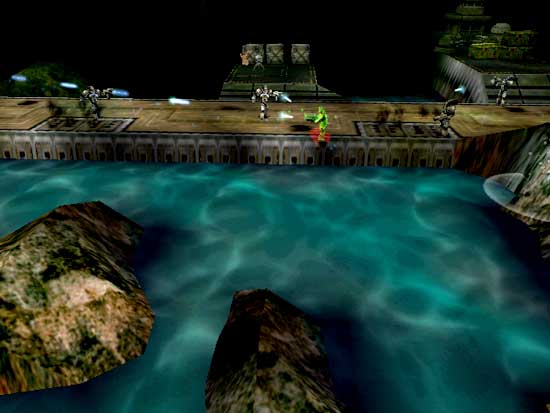Gigabyte GA-MG400 Matrox G400 AGP
by Anand Lal Shimpi on February 3, 2000 4:02 AM EST- Posted in
- GPUs
Environment Mapped Bump Mapping
Taken from our G400 & G400MAX Review
While Matrox can't claim exclusive rights to the technology behind VCQ2, they can claim that they are the only desktop accelerator in this scope that supports a technology known as Environment-Mapped Bump Mapping. Bump Mapping is a technology that allows a texture to appear more realistic by the inclusion of individual bumps in the texture. If you look closely at a painted wall in real life (not in Q3A world guys) you'll notice that the wall isn't perfectly smooth, there are bumps and numerous imperfections. Bump Mapping essentially allows for those bumps to be put on walls and basically any textures in a game. It truly makes your gaming experience something else. NVIDIA supports a type of bump mapping known as embossed bump mapping, which can be considered a form of what we're talking about, but not the best and most realistic. Embossing is basically a cheap work around to avoid Dot Product 3 or Environment-Mapped Bump Mapping, the latter being the implementation Matrox used in the G400.
Instead of manipulating a standalone texture map to make it "look" like it has bumps on it, Environment-Mapped Bump Mapping adds a third texture to the rendering sequence (in cases where both an Environment Map and a Texture Map are present). The third texture, or the bump-map, is nothing more than the basic environment map with bumps and grooves. Since the G400 is capable of single pass multi-texturing (as well as 2 pixels per clock in the event that only a single texture is being processed), the Environment Map and Texture Map are processed first in 1 clock cycle, then the Bump-Map is added on top of them in 1/2 a clock cycle. It's simple addition of textures, unfortunately the added 1/2 clock cycle required by the Bump-Map does tend to slow things down by a noticeable degree.
Using Rage Software's Expendable, an incredible looking game, there was a noticeable drop in frame rate when Bump Mapping was enabled near points of extensive use of Environment-Mapped Bump Mapping. If you look at it from the point of view of the G400 chip itself, it makes sense that there would be a drop in performance as you're making the processor calculate information for another 1/2 clock cycle just so you can look at pretty water - the things we make our computers do ;)
The two screenshots below are some of the most impressive uses of EMBM, but unforuntately, since the release of the G400 back in May of 1999, this single screenshot has been one of the only good uses of EMBM. While we have seen it in other games, the water in Expendable was the best use of EMBM we have ever held witness to.
No Bump Mapping

Environment Mapped Bump Mapping

EMBM support in current games isn’t as great as we originally expected it to be. Very few of the major titles support EMBM, and the games that do support it, don’t make extensive use of the technology. And in the areas that they do use EMBM extensively in, the G400 doesn’t have a high enough fill rate to keep up a playable frame rate.










0 Comments
View All Comments